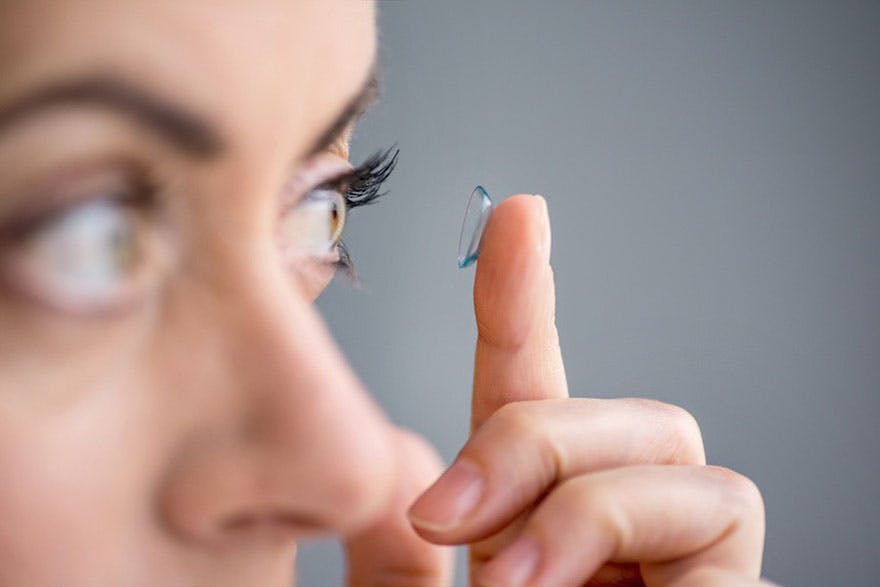Contact lenses: What to know before you buy
HEALTH & WELLNESS
10.21.2014

Thinking about trying contact lenses? Contact lenses are more versatile than ever before. Start by understanding the pros and cons of common types of contact lenses — and the ground rules for preventing eye infections.
Soft contact lenses
MSoft contact lenses are the most popular type of contact lens both in the United States and worldwide. Soft contact lenses can be used to correct various vision problems, including:
Nearsightedness (myopia)
Farsightedness (hyperopia)
Blurred vision (astigmatism)
Age-related loss of close-up vision (presbyopia)
Soft contact lenses conform to the shape of your eye. They're comfortable and tend to stay in place well, so they're a good choice if you participate in sports or lead an active lifestyle.
Soft contact lenses come in various types, such as:
Daily wear. Daily wear soft contact lenses are typically the least expensive option. You wear the lenses during the day, and remove them each night to be cleaned and disinfected. How long you can use a single pair of daily wear lenses varies depending on the manufacturer.
Extended wear. You can wear extended wear soft contact lenses while you sleep, but they must be removed for cleaning and disinfecting at least once a week. It's still important to be cautious with overnight use, though, since it increases the risk of eye infections — even if the lenses have been approved for extended wear.
Disposable. Disposable soft contact lenses are generally the most expensive option. You wear the lenses during the day and remove them at night. They don't need to be cleaned or disinfected. You simply use them for the recommended timeframe — such as daily, weekly or monthly — and then discard them. You might consider disposable lenses if you wear contacts only occasionally, you can't tolerate disinfecting solution or you place a premium on convenience.
Hard contact lenses
Rigid, gas permeable lenses, or hard contact lenses, provide clear, crisp vision for most vision problems. Hard contact lenses might be especially appealing if you've tried soft contact lenses and been unsatisfied with the results.
Hard contact lenses are often more breathable than are soft contact lenses, which reduces the risk of eye infections. Most hard contact lenses must be removed for cleaning and disinfection at night.
It might take up to a week to adjust to hard contact lenses, and they're more likely to slip off the center of your eye than are soft contact lenses — which might lead to discomfort and blurred vision.
If your prescription doesn't change and you take care of your hard contact lenses, you can use the same pair of lenses for up to two to three years.
Specialized contact lenses
Depending on your vision needs, you might consider specialized contact lenses, such as:
Hybrid contact lenses. Hybrid contact lenses feature a hard (gas permeable) center surrounded by a soft outer ring. Hybrid contact lenses might be an option if you have an irregular corneal curvature (keratoconus) or you have trouble wearing traditional hard lenses.
Bifocal or multifocal contact lenses. These lenses, which are available in both soft and hard varieties, can correct nearsightedness, farsightedness and astigmatism in combination with age-related loss of close-up vision (presbyopia).
Tinted contact lenses. Some contact lenses are tinted, either for cosmetic or therapeutic purposes — to enhance color perception or help compensate for color blindness, for example. Avoid costume or decorative contact lenses, though. These lenses can damage your eyes and cause potentially serious eye infections.
Getting the right fit
If you decide you want to try contact lenses, consult your ophthalmologist or other eye care specialist for a thorough eye exam and fitting.
Schedule follow-up exams as recommended by your eye care specialist. You might need a follow-up exam after one week, one month and six months, and then once a year.
Avoiding eye infections
Wearing contact lenses of any type increases the risk of corneal infection, simply because contact lenses reduce the amount of oxygen that reaches the corneas. Eye infections aren't inevitable, however.
To prevent infections:
Practice good hygiene. Wash, rinse and dry your hands thoroughly before handling your contacts.
Remove your contacts before you go to sleep. This applies to extended wear contacts, too. Although extended wear contacts are designed to be worn overnight, continuous wear significantly increases the risk of eye infections.
Minimize contact with water. Remove your contact lenses before you bathe, swim or use a hot tub.
Don't moisten your lenses with saliva. Resist any temptation to put your lenses in your mouth to wet them.
Take care with contact lens solutions. Use only commercially prepared, sterile products designed specifically for the type of contact lenses you wear — not water or homemade saline solution. Discard the solution in the contact lens case each time you disinfect the lenses, and don't "top off" old solution that's already in the case.
'Rub and rinse' your lenses. Gently rub your lenses while you're cleaning them, even if you choose no-rub solution.
Keep an eye on the expiration date. Don't use contact solution that's past the expiration date.
Replace contact lenses and cases as recommended. Follow manufacturer guidelines for replacing your contact lenses — and replace your contact lens case every three to six months.
Even with proper use and care, dry eyes can be an issue for contact lens wearers. If your eyes are itchy or red, remove your contact lenses and use lubricating eyedrops.
If your vision becomes blurry or you experience eye pain, sensitivity to light or other problems, remove your contact lenses and consult your eye care specialist for prompt treatment.
©1998-2013 Mayo Foundation for Medical Education and Research (MFMER). All rights reserved. Terms of Use
Image Credits: ESB Essentials/Shutterstock.com
Recommended Articles
The 5 Best Foods That Will Help Supercharge Your Brain
Amidst our busy schedule, it's important to retain our focus and memory. Resting alone is not...
Iron deficiency is a lot more common than you would think. A recent survey by SATA CommHealth(i...
Mars vs Venus: Understanding the His and Hers of Nutritional Needs
Mars vs Venus: Understanding the His and Hers of Nutritional Gaps Although their DNAs are...






